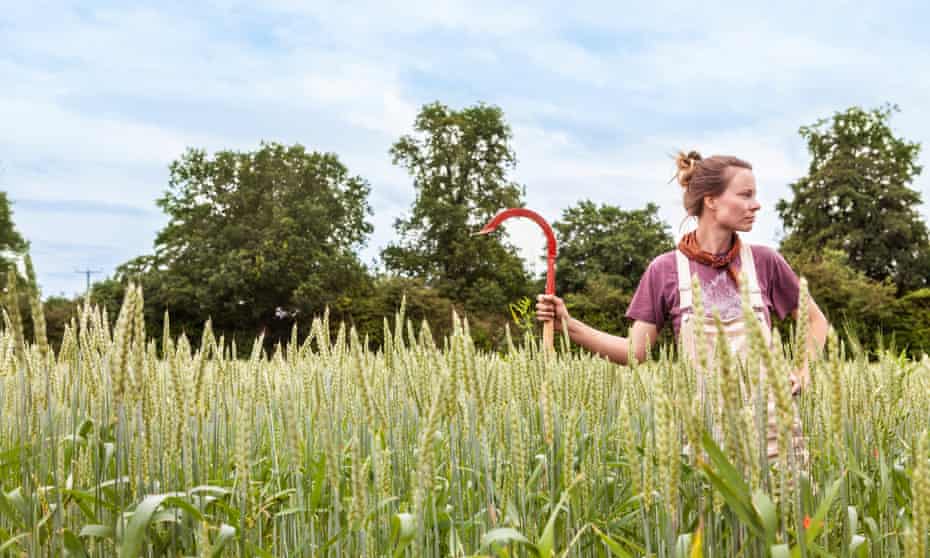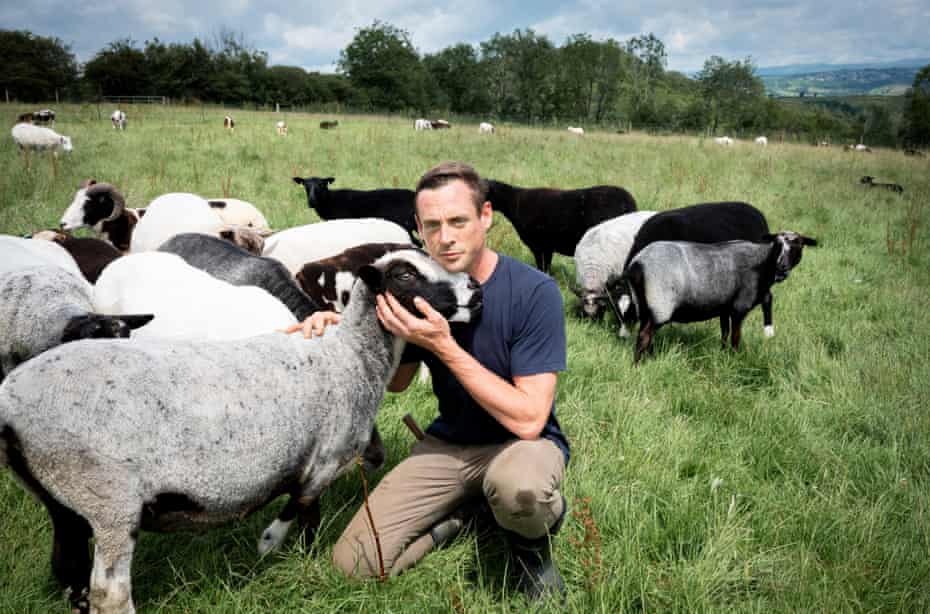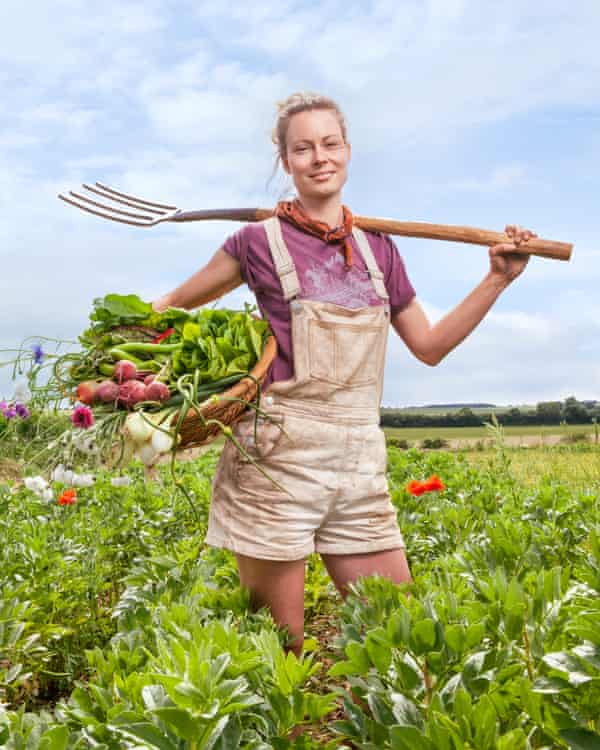‘Sustainable isn’t a thing’: why regenerative agriculture is food’s latest buzzword

Everyone from small farms to McDonald’s is getting involved in regenerative agriculture. Could it point the way to a better future for farming?
A pheasant struts around the Garden of Eden. The pheasant is, well, a pheasant, a male, with those long, jaunty tail feathers; the Garden of Eden is the semi-serious name given by Dan Cox, a 39-year-old chef turned farmer, to a patch of land about half the size of a football pitch on his farm in south-east Cornwall. Cox began working on it in 2017 and it is his experiment to create a growing space in complete harmony with nature, but also productive and bountiful with some of the most delicious vegetables you will ever taste.
Cox looks at the pheasant, which is picking at his seeds and shoots, and squints. “They’re like colourful Chinese chickens that have been bred for stupidity and flying upwards,” he says. “There’s nothing good about them. They don’t taste nice. They’re not supposed to be here. They’re very aggressive. You’re going about your business in your garden and the cocks are coming and attacking you. Crazy! Something’s gone wrong, something’s been removed from the system somewhere to allow that thing to flourish in the first place.”
Combative pheasants are just one of the challenges Cox has faced since becoming a farmer. But, he admits cheerfully, he could name hundreds. In his 20s, Cox seemed to be on a comparatively straightforward path to becoming one of Britain’s most celebrated chefs: a Kerridge, a Smyth, a Bains. In 2008, aged 26, he won the Roux scholarship. Three years later, Simon Rogan recruited Cox to head up L’Enclume’s test kitchen. But two months after Cox arrived in the Lake District, the couple who ran the restaurant’s two-acre farm decided to retire.
“L’Enclume without a farm at that point wasn’t a thing: that’s where the story was and having access to that incredible produce,” says Cox, who grew up in urban north London and whose experience of growing was limited to herbs and microgreens in his back garden. “So we were like: ‘How hard can it be? Let’s just do it ourselves.'”
A rueful laugh: so far, so Clarkson’s Farm. But Cox has an obsessive streak and a wandering, irrepressible curiosity. He began reading everything he could find on farming and soil (sample: Darwin’s lesser-selling The Formation of Vegetable Mould Through the Action of Worms), visiting suppliers and asking endless questions. “My thinking was: we’re a two-Michelin-star restaurant up in the Lake District – that’s where we are,” he explains, putting his hand above his head: a high bar. “So who’s the equivalent to us in farming? And I couldn’t really see anyone in the UK that was doing that.”
Cox’s farm, Melilot, the name taken from sweet clover, is his attempt to create this arcadia. In May, he gave me a tour: the rain lashed us, the wind was unseasonably mean and the ground was struggling to recover from the cataclysmic spring: too dry, too wet, then too cold. But the promise of this fertile, temperate spot is unmistakable: there are more than 70 different plants being grown for sale over 80 acres and 260 rare-breed sheep loll around. Cox is tall and strapping and he takes giant strides, stopping every so often to cut an asparagus spear or an artichoke globe with his Niwaki hunting knife, or pick a sprig of mint that tastes like an After Eight.
It is what’s happening below ground level, though, that really excites Cox. All food, he believes, is only as good as the soil in which it is grown. The magic here is harder to see – around 20,000km of hyphae, or fungal filaments, snake through every square metre of healthy soil – and it is less sexy to talk about than an heirloom variety of pink celery. But Cox is adamant that if we care about what we eat, and the survival of the planet beyond that, we need to make soil a priority. He practises no tilling on the land at Melilot, which minimises soil disturbance and in turn prevents erosion and allows the ecosystem to thrive. He also uses no pesticides or chemical fertilisers. “Improve soil health, improve nutrition,” he says. “Improve nutrition, improve flavour.”

Cox’s operation is tiny in the context of farming in the UK, where almost three-quarters of the land is used for agriculture. But he hopes his work can plant a seed for how to do things differently. “Conventional farming is a travesty, it’s so fucked,” he says. “Everyone’s talking about sustainability, but why would you sustain something that’s wrong? It’s like sustaining a marriage, sustaining a relationship with your child. Dude, that’s not what you want to do. You want to develop and evolve, make it as good as it can be. Sustainable isn’t a thing, it’s about regeneration.”
Regeneration is a buzzword in farming these days. It is the subject of Ted talks: Allan Savory, a farmer originally from Zimbabwe and a leader in the movement, claimed in a 2013 lecture watched online at least 7.5m times that following its principles could “reverse” climate change. It has a Netflix documentary, Kiss the Ground, a 2020 film narrated by Woody Harrelson, which jumps off from the UN’s projection that unless we find a way to repair our soil, we have only 60 harvests left before our topsoil is gone (though this claim is contested by recent research from Oxford University, which called it “overblown”). Gabe Brown’s 2018 book, Dirt to Soil: One Family’s Journey into Regenerative Agriculture, is the movement’s holy text. Brown, a North Dakota rancher and farmer, landed on regenerative methods in the 1990s after four years of freak storms led to huge crop failures and cattle deaths. He argues there are numerous benefits for farmers who focus on the health of their soil, not least the money they will save on fertiliser and other treatments. Healthy soils also absorb water and carbon dioxide, and Brown’s land has been shown to have up to three times as much soil carbon as that of his neighbours. It’s argued that, if emulated on a large scale, this could have a significant impact on global heating.
There is no set definition of regenerative agriculture or “regen ag” as it gets called. But stripped back, it is any form of farming – that is, the production of food or fibre – which at the same time improves the environment. Regenerative farmers typically try to disturb the soil as little as possible: forgoing tilling, which disturbs the complex network of worm-holes, fungal hyphae and a labyrinth of microscopic air pockets, and avoiding heavy doses of fertiliser or sprays. Most advocates grow a diverse range of crops, often at the same time, and believe that grazing animals are essential for improving soil health.
The most elegant expression of why regenerative agriculture should be at the heart of British farming is James Rebanks’s 2020 book, English Pastoral. Rebanks, whose family have farmed in the Lake District for 600 years, avoids easy scapegoating for the hole that many farmers now find themselves in. But he’s clear that to protect our food system and our landscape, we need to change – or regenerate.
For most of his life the 46-year-old Rebanks admits that he considered advocates of regenerative agriculture to be “cranks”. They had to be: British farmers effectively tripled their per-acre yields of wheat, oats and barley, and doubled milk production between 1935 and 1998. New chemicals and more powerful machinery were at the heart of this boom. But by the time that Rebanks’s father died in 2015, leaving him with a loss-making farm with around 500 Herdwick and Swaledale sheep, the picture had changed. The cranks had a point. “The evidence started to mount across my lifetime that actually their scepticism is bang on the money, really,” says Rebanks on a video call.
In the years since his father’s death, Rebanks has set about remodelling the farm. He has not used artificial fertiliser since taking it over. He has planted trees and, at great effort and expense, moved a stream that passed through his best hay meadow to a more natural channel nearby, which created new ponds and wetlands. (The construction company was bemused why someone would make their field “worse”: “The kind of lunacy only college-educated people could come up with,” he writes in English Pastoral). The changes have not made Rebanks rich, but the farm does now turn a profit. And, just as important to him, the ecosystem is more vibrant than it has been in decades.

“I had a vague idea that if you did the right things for nature you might then wait another 20 years until things came back,” says Rebanks. “But when we left some longer grass to grow we had barn owls return to the farm within about three months. The feedback loop is exhilarating. You do a thing, then a good thing happens. And it’s clearly because you’ve done something better or you stopped doing something bad.”
The message is a heartening one and Rebanks reaches a large audience through his books and his 150,000-strong Twitter following. But he remains conflicted and concerned. “Oh my God, we work incredibly hard for almost no money,” he says. “I don’t expect anybody to shed tears for us not making a fortune, but that worries me because if doing the right thing ultimately doesn’t pay enough to persuade my neighbours, I’m not sure they’re all going to do it. There’s almost a public interest in making the right thing pay better than this.”
Rebanks knows that government ministers have read English Pastoral, but he thinks there is a cognitive dissonance between politicians who talk about protecting British farmers and our countryside while negotiating trade deals with Australia and expecting British farmers in “small, crooked fields” to compete with North American levels of productivity. “Everything about our food farming and land management system is brewing up to be worse, not better,” says Rebanks. “I know bad news is boring, but we’re at a tipping point where we could make really good, profoundly countryside-changing decisions, and we’re not making them.”
In late June 2021, more than 3,500 regenerative farmers came together for a two-day festival in Hertfordshire called Groundswell. Because of the loose definitions, it’s hard to say how many UK farmers are following regenerative practices, but put it this way: previous editions of Groundswell have taken place in one, admittedly quite large room; this year, the festival had seven stages and sprawled over multiple fields. You could – and people actually did – call it the “Glastonbury of farming”.
One of the biggest and most boisterous crowds was for the talk given by George Eustice, the secretary of state for environment, food and rural affairs. “Everyone recognises the need to change our approach to tackle the environmental challenges, both on climate change, but also on biodiversity,” said Eustice. “And leaving the European Union gives us, as a country, a great opportunity to show the world how we can do this: an opportunity through this seven-year transition to completely reorder the incentives in our system, so that we support a regenerative agriculture. And that is precisely what we want our future policy to do.”
Eustice followed this up in July with the sustainable farming incentive, which promises to pay farmers up to GBP70 per hectare for actions they take to improve the health of their soil. These measures, which will roll out from spring 2022, are encouraging for the regenerative movement, even if many farmers, including Rebanks, still believe the government’s message is either contradictory or disingenuous.
Elsewhere at Groundswell, there was much discussion about how to bring the public along with the movement. “We are unashamedly in the orgasm business,” said Peter Greig of Pipers Farm, who has been farming in north Devon for 30 years and now works with 40 local, small-scale farmers to bring regenerative products to market. “Our job as food producers is to give people pleasure. Number one, if they eat something, and they think ‘Bloody hell,’ and they remember it, they will come back and buy it again. And it’s very obvious that the way to produce food that is absolutely fabulous to eat is to revert to nature.”
One of the most invigorating talks at Groundswell came from Calixta Killander, a 31-year-old farmer from Cambridgeshire. She grew up on a large-scale arable farm, but had little interest in the land until she studied sustainable agriculture in North Carolina when she was 21. This led to a spell on an Amish farm, Sugar Creek in Ohio, and a conviction that she wanted to try horse-powered farming in the UK. She was gifted a pair of Comtois heavy horses, Bill and Ben, and started her business, Flourish Produce, on four acres just off a busy A-road.
When Killander began, she was, she tells me, “the laughing stock of the local farming community”. But horses weren’t the only unusual aspect of Flourish. Killander decided that she would have the greatest impact by growing for chefs and that in doing so she could stick most closely to regenerative principles. To do that, she chose to specialise in “niche” vegetables and lots of them. Five years on, Flourish spreads over 50 acres and grows more than 800 varieties. “Which is absolutely crazy for the spreadsheet we need to run the farm,” she admits. “I can barely keep it all together, but so far we’re managing.”

Flourish sells vegetables, fruits, herbs and flowers direct to restaurants including London’s Brat, Orasay and Ikoyi. Many of these varieties are difficult or impossible to get anywhere else, such as robin’s koginut squash, which are individually hand-washed, hand-polished and cured for months before being sold. “Which might make it sound like it’s definitely not economically viable to do them,” laughs Killander, “but we found that there’s such a huge demand we often sell out of the squash within just a few hours of opening them up to our chefs. So there’s a lot to be said for trying to grow things that have that competitive edge on the market.”
It is unlikely that you will find robin’s koginut squash in your Tesco Metro in the foreseeable, but that’s not exactly the point. Chefs and produce obsessives always exist in a rarefied space. Their power comes from influencing people who eat their food and read their cookbooks, and the messaging trickling down from there into better, more flavourful food for a mass market. There’s evidence that is starting to happen: McDonald’s UK is two years into a four-year project to produce beef farmed under regenerative guidelines. The chain’s stated goal is to restore soil quality, boost diversity and draw more carbon into the earth than it produces.
There are even signs that some of the farmers around Killander who were dubious when she arrived are becoming more open-minded. “My neighbour is a conventional farmer, and I was amazed when earlier this year he mentioned having read Gabe Brown’s book and was interested in growing peas and rotating his cattle on the land,” she says. “It just shows that there is change happening.”
There is an appealing zealousness to the regenerative farmers I meet, and a shared belief that – despite the odds – the bleak projections for food production and global agriculture are reversible. But no one is finding it easy and no one is getting rich quick. Killander had her biggest single day of sales in March 2020, only for the government to order the shutdown of UK restaurants. “The van went to London and all that produce came back and was wasted,” she recalls. After the erratic weather this spring, Flourish lost 60% of its crops and had to temporarily close the farm down and tell its restaurants it couldn’t supply them.
Soaked through and mud-caked in Cornwall, it’s hard not to wonder if Dan Cox regrets, at least for now, leaving life in the kitchen. He insists he doesn’t, but he has no doubt that what he’s trying to do now is much harder. “In a restaurant, if you are not happy with a dish at lunchtime, it’s different for dinner,” he says. “You just ring up your supplier and get a second delivery. But with farming, everything takes at least six months or a year to see the results and to make the change. To come into a situation where you have almost no control is quite hard.”
If you’re thinking you would like to support regenerative farmers, there’s one obvious way: buy their products when you see them, seek them out. In 2020, Cox partnered with Natoora, which supplies unique and “radically” seasonal produce from the UK and Europe to chefs and home customers direct and through Ocado. In lockdown, Flourish began selling vegetable boxes and flowers, with pick-ups in Cambridge and London, and Killander is now taking orders for autumn.
But all of the farmers make an unexpected, counterintuitive plea. “It may surprise you,” says Rebanks, “but I think as many people as possible should try – to whatever extent is possible for them in their situation – to grow something that they eat.” You’ll quickly learn, Rebanks believes, how difficult (and maddening!) it can be, but also that the prices we pay in supermarkets are often unsustainably meagre. “We’re all of us, and it’s true of me for the plants that I eat, way too disconnected,” he continues. “We forget what this is all about and how hard it is.”
